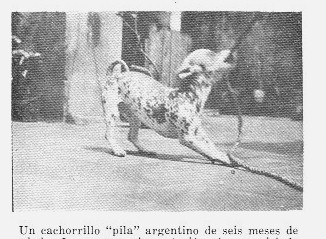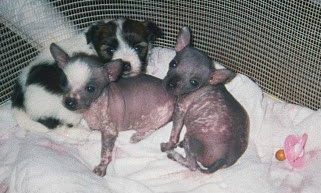Links to:
HomeXolo
Mexican Hairless
pila dog
Normal?
Coated
The gene
Ancient dogs
Elephant Dog
PIO
Genetic Registry
Contact
Genetic Registry for Hairless Dogs
Genetics |

Coated
The coated dogs in hairless litters are not the same as coated dogs from breeds without hairless members. Hairless bred to outside coated dogs produce distinctly different litters than those bred to coated dogs from the hairless breed.
Making the assumption that the only difference is a single gene for hairlessness is the reason most 'studies' of hairless dogs by geneticists produce no conclusive results.
In AHT, American Hairless Terrier, the only purely recessive hairless breed we know today, breeding to dogs without hairless members in their lines means at least one and often two generations before hairless pups are produced.
In dominant hairless lines, breeding two hairless or a hairless to a coated breed member will produce 2 hairless to 1 coated offspring.
If a hairless is bred to an outside coated it will produce 3 coated to 1 hairless to 2 intermediate coated of a type not usual in hairless. This intermediate coat is similar to some pila types, but in these mixed litters often the skin is not right and such pups have a high incidence of early deaths.
In healthy intermediate coated with dark Xolo skin, they breed true as Xolos. But the one of six with the nice hairless body, often looking like a perfect show Xolo, is not accepted by other hairless as one of them, and produces pups that do not do well for various reasons often related to temperament.

What is 'normal' for hairless dogs?
In the 1980's, in Chinese Crested, Mexican Hairless, Xolos and all other hairless dogs (except AHT), it was usual for toy litters to have 4 hairless to 1 coated.
Standard Xolo had 9 or 10 pups with 7 or more hairless, and one to 3 coated (there were no mini Xolos then).
I believe this is the norm for a natural mix of Xolo and pila genes in sound and diverse gene pools. When dogs were 'scientifically bred' some went to mostly hairless, ands over the generations the lines dwindled, often from cancer. Xolo litters went to the 2:1 ratio and so did Crested litters. In the early days, before the Crested were in the AKC lines, true powderpuffs who bred many powderpuffs began to get fewer hairless until many lines had litters of 4 powderpuff to 1 hairless.
(Later I show a photo of Xolos who recently came to this ratio or worse, from unknown reasons.)

On size
It was a mystery to me when people began to get miniature Xolos, because in my experience even breeding toy to standard, the offspring went either way and did not produce a middle size. It has become clear to me now that the middle sizes are from pila blood - if one follows the guideline I suggest, Xolos will be 12-13 pounds or 40 pounds.
Dogs that get 9 pounds or under, 14-17 pounds, 23-27, 33-37, or over 45 pounds, will be distinct varieties of pilas.
The Mexican Hairless are the exception, and will be 6 to 14 pounds due to the balanced blend of pila genes they have.
I believe that these dogs are the most direct descendents from the ancient original Mexican breed, the Techichi. This dog is also the origin of the Chihuahua, which explains why very small hairless have Chihuahua traits - it is not from breeding to Chihuahua.
It is also likely that the 'Hairless Chihuahuas' seen decades ago were a descended type and not a mix.
Pila produce smaller dogs than the 12 pound toy Xolo size, or even the under 9 pound Mexican Hairless.
The first picture is from 'Enigma' and the second are pups in a San Bernardino litter. Although the dogs are pups, they are much smaller than toy Xolo pups, and may grow to no more than 4 pounds at maturity.

